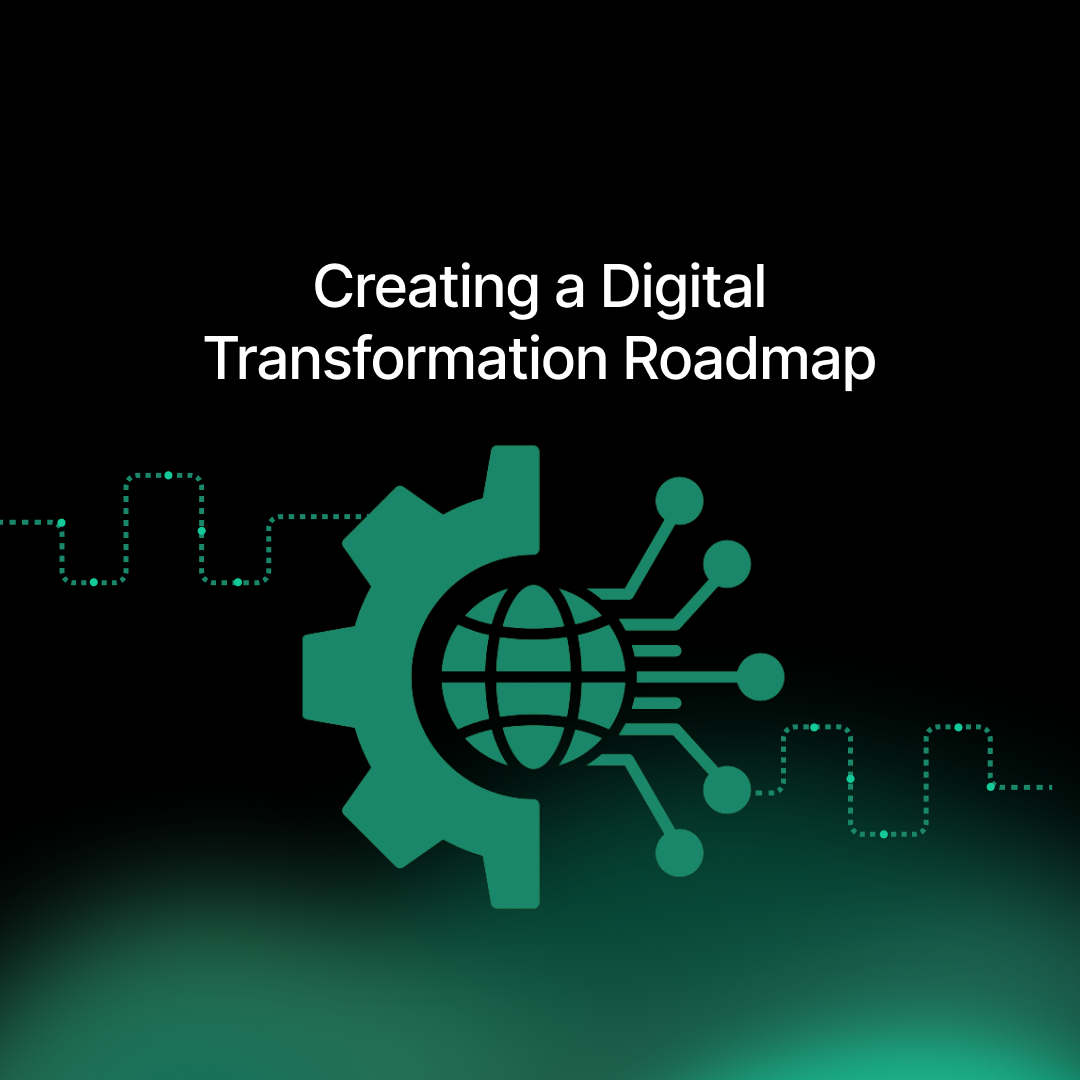Creating a Digital Transformation Roadmap
- Nitin Yadav
- Blog
About

Build an effective digital transformation roadmap to align tech and business goals. Engage stakeholders, choose scalable tools, and pilot adaptively. Start planning now!
Industries
- AWS, DevOps, Terraform
Share Via
Digital transformation has never been bigger and more popular than now, across the world. Organizations across all sectors recognize the need to adapt and integrate digital technologies to remain competitive and meet evolving customer demands. In fact, 89% of companies worldwide either have or want to adopt a digital-first approach.
A well-defined digital transformation roadmap acts as a crucial guide in this journey, ensuring that the work and resources you put into your digital transformation strategy pay off. This article provides a comprehensive overview of creating an effective digital transformation roadmap.
To begin with, let’s understand the nuances of digital transformation and the ways in which companies can go digital.
Understanding Digital Transformation
To put it simply, digital transformation is strategically integrating digital tools and technologies into every facet of an organization, driving significant improvements and creating new opportunities.
Most business functions benefit from digital transformation, from internal processes and organizational culture to external customer interactions and market engagement.
There is an entire world of technologies that get incorporated into digital transformation strategies, and some of the most popular ones include:
- Cloud Computing: Moving data, applications, and infrastructure to the cloud allows for greater scalability, flexibility, and cost-effectiveness. It enables access from anywhere with an internet connection and promotes collaboration.
Also read: On-Premise vs Cloud: A Comparative Analysis
- AI and ML: Perhaps the most trending technologies in digital transformation now, with an adoption rate of over 72% worldwide, according to McKinsey. AI and ML have truly transformed the digital adoption landscape.
- Internet of Things (IoT): Did you know that you can interface multiple physical devices to the Internet? This allows for data collection, remote monitoring, and automation of physical processes, creating new efficiencies and possibilities.
- Big Data and Analytics: Collecting and analyzing large datasets provides valuable insights into customer behavior, market trends, and operational performance, informing strategic decision-making.
The impact of these digital transformation technologies extends significantly to customer value and interactions. Personalized customer experiences become possible through data analytics and AI, the best in cloud technology, and marketing campaigns catering to individual preferences.
Omnichannel customer engagement ensures a seamless and consistent experience across all touchpoints, from websites and mobile apps to social media and in-store interactions.
Now, let’s understand what a digital transformation roadmap is and the steps involved in creating one for your organization.
What is a Digital Transformation Roadmap?
A digital transformation roadmap is a strategy that outlines the path an organization will take to achieve its digital transformation goals. This roadmap acts as a bridge between the current state of an organization’s technology and processes and its desired future state. It provides a structured framework for managing the complex interplay of technology, people, and processes involved in transformation initiatives. A strong roadmap includes specific tasks, realistic timelines, and detailed project plans. It clarifies priorities and helps allocate resources effectively.
Digital transformation roadmaps play a critical role in ensuring the success of transformation efforts. These are some of the most critical functions of a roadmap:
- Ensures Alignment: It guarantees that all digital initiatives align with overarching business goals. This alignment ensures that technology investments directly support the organization’s strategic direction.
- Visualizes Execution: A roadmap also provides a clear visualization of how the transformation strategy will move into practical execution. It offers a tangible plan that stakeholders can more easily understand and follow.
With that said, let’s take a look at the steps to create a digital transformation roadmap now.
Key Steps to Create a Digital Transformation Roadmap

Creating a robust digital transformation roadmap involves the following steps.
Step 1: Assessment
This initial phase involves a thorough evaluation of your organization’s current digital maturity. A technological assessment scrutinizes existing IT infrastructure, systems, data management, and cybersecurity posture, identifying strengths and weaknesses. You can also consider an audit of the workforce’s digital capabilities, pinpointing skill gaps and training needs.
This assessment establishes a crucial baseline for the digital transformation journey, informing subsequent planning and resource allocation.
Step 2: Define Objectives
This step focuses on establishing proper objectives for the digital transformation. These objectives provide a concrete direction for the entire initiative and ensure alignment with the overall business strategy. Defining objectives involves:
- Outcome Focus: Clearly articulating the desired business outcomes of the transformation. This answers the fundamental question: “What specific business improvements do we expect to see as a result of this digital transformation?”
- Measurable Metrics: Defining specific, quantifiable metrics to track progress and measure the success of the transformation. These metrics could include things like increased online sales, reduced customer churn, improved operational efficiency, or faster time-to-market.
Step 3: Engage Stakeholders
Another crucial step focuses on ensuring active participation from key stakeholders throughout the organization. It mainly involves:
- Identifying Key Stakeholders: Pinpointing individuals and groups who have a vested interest in the transformation, including executives, department heads, employees, customers, and suppliers.
- Communicating the Value Proposition: Clearly articulating the benefits of the digital transformation for each stakeholder group, emphasizing how it will improve their work and drive ROI.
- Addressing Concerns and Objections: Actively listening to stakeholder concerns, providing clear and honest answers, and developing strategies to mitigate potential risks or disruptions.
Step 4: Choose the Right Tools
Selecting appropriate and scalable technologies forms a crucial part of the roadmap. Key considerations here include:
- Scalability and Flexibility: Selecting tools that can scale to accommodate future growth and adapt to changing business requirements.
- Integration Capabilities: Ensuring that chosen tools can integrate effectively with existing systems and data sources to avoid data silos and ensure seamless data flow.
- Cost-Effectiveness: Evaluating the total cost of ownership (TCO), including licensing fees, implementation costs, maintenance, and training.
- Security and Compliance: Prioritizing tools that meet stringent security standards and comply with relevant industry regulations.
Did you know that SquareOps can help you select the best solutions for your digital transformation through our DevOps consulting? Read more on how we achieve this.
Step 5: Allocate Resources
Successful digital transformation requires adequate resources across various areas. This involves developing a realistic budget covering technology investments (software, hardware, cloud services), personnel costs (salaries, consultants), training programs, and ongoing maintenance.
Resources (financial, human, and technological) must be assigned to specific projects based on priority and strategic importance, with clear prioritization of which projects receive funding and personnel first.
Step 6: Develop Management Approach
A well-defined management approach is invaluable when you’re overseeing the digital transformation process. Key elements of a robust management approach include:
- Roles and Responsibilities: Clearly define the roles and responsibilities of project managers, team members, and other stakeholders. This ensures that everyone understands their contribution to the transformation.
- Project Management Methodology: Selecting an appropriate project management methodology (e.g., Agile, Waterfall) to guide the transformation.
- Feedback Loops and Monitoring: Implementing mechanisms for gathering feedback from stakeholders, tracking key metrics, and monitoring progress against objectives. This allows for timely adjustments and course correction as the transformation progresses.
Step 7: Pilot and Iterate
Finally, it’s best to conduct small-scale pilot projects before you start rolling out various phases of your transformation. These pilots provide an opportunity to test assumptions, gather feedback, and make necessary adjustments before wider deployment. This iterative approach reduces risk and increases the likelihood of success.
Before we move on to some best practices to keep in mind during your digital transformation roadmap, there is an important distinction you should learn about.
Digital Transformation Strategy vs. Roadmap

There is a chance that you may have come across the term “digital transformation strategy” before. While there are some intersections between the two, there is also a fundamental difference.
- Strategy: The strategy defines the high-level vision, objectives, and desired outcomes of the transformation. It answers the “why” and “what” of the transformation.
- Roadmap: The roadmap provides the practical application of the strategy. It outlines the specific steps, timelines, and resources required to achieve the strategic objectives. It answers the “how” and “when” of the transformation.
Both elements are essential for a successful transformation. The strategy provides direction, while the roadmap provides the plan for execution.
Now, let’s take a look at some guidelines to truly have a flawless execution of your digital transformation roadmap.
Best Practices for Deploying a Roadmap
Several best practices contribute to the effective deployment of a digital transformation roadmap
- Build a Culture of Change: Change is the only constant, and a culture that accepts change is important. This means encouraging experimentation, learning from failures, and recognizing successes.
- Prioritize and Phase: Implementing all changes simultaneously can overwhelm an organization. Prioritizing initiatives and implementing them in phases allows for better management and reduces disruption. Agile methodologies often work well for this.
- Engage Employees: Employees play a vital role in the success of any transformation. Engaging them early in the process, providing training, and appointing change ambassadors can smooth the transition.
A Roadmap For The Future
A structured digital transformation roadmap provides a clear path for integrating technology into business processes. It’s important that you monitor every stage of the transformation and adapt to changing circumstances to ensure lasting results.
By engaging stakeholders, aligning technology with strategy, and implementing changes in a controlled and iterative manner, there’s no reason why you shouldn’t be able to achieve optimal digital transformation.
Of course, SquareOps is here to help you take care of the finer details in your digital transformation, having helped multiple clients over the past years accelerate their roadmap. With our expertise in technology like the cloud, we’ll make sure there are no hitches on this journey.
Click here to talk to us!
Frequently asked questions
It’s a strategic plan that guides your organization’s digital transformation journey, ensuring alignment with business goals and effective execution.
Key steps include assessing your current state, defining clear objectives, engaging stakeholders, choosing the right tools, allocating resources, establishing a management approach, and piloting/iterating.
A strategy defines the overall vision and objectives (the “why” and “what”), while the roadmap details the practical steps and timelines (the “how” and “when”).
Communicate the benefits clearly, address their concerns, and create a collaborative environment.
Consider your specific needs, scalability, integration with existing systems, cost-effectiveness, and security.
It ensures that each project has the necessary budget, personnel, and technology to succeed and contribute to the overall transformation.
A structured approach provides governance, clear roles, feedback mechanisms, and the ability to adapt as the transformation progresses, ensuring accountability and control.
Track specific, measurable metrics tied to your defined objectives, such as increased revenue, improved customer satisfaction, or enhanced operational efficiency.
Related Posts

Comprehensive Guide to HTTP Errors in DevOps: Causes, Scenarios, and Troubleshooting Steps
- Blog

Trivy: The Ultimate Open-Source Tool for Container Vulnerability Scanning and SBOM Generation
- Blog

Prometheus and Grafana Explained: Monitoring and Visualizing Kubernetes Metrics Like a Pro
- Blog

CI/CD Pipeline Failures Explained: Key Debugging Techniques to Resolve Build and Deployment Issues
- Blog

DevSecOps in Action: A Complete Guide to Secure CI/CD Workflows
- Blog

AWS WAF Explained: Protect Your APIs with Smart Rate Limiting
- Blog

